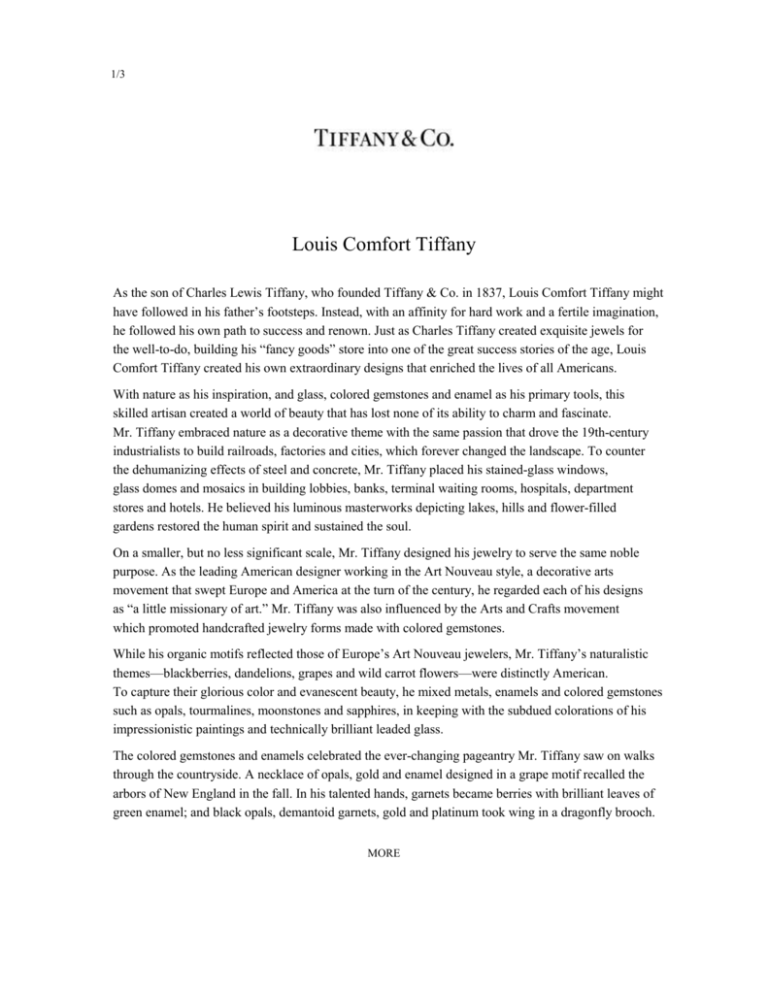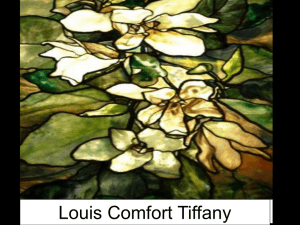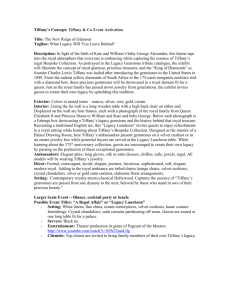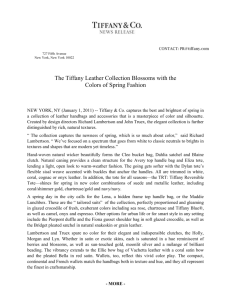in Word
advertisement

1/3 Louis Comfort Tiffany As the son of Charles Lewis Tiffany, who founded Tiffany & Co. in 1837, Louis Comfort Tiffany might have followed in his father’s footsteps. Instead, with an affinity for hard work and a fertile imagination, he followed his own path to success and renown. Just as Charles Tiffany created exquisite jewels for the well-to-do, building his “fancy goods” store into one of the great success stories of the age, Louis Comfort Tiffany created his own extraordinary designs that enriched the lives of all Americans. With nature as his inspiration, and glass, colored gemstones and enamel as his primary tools, this skilled artisan created a world of beauty that has lost none of its ability to charm and fascinate. Mr. Tiffany embraced nature as a decorative theme with the same passion that drove the 19th-century industrialists to build railroads, factories and cities, which forever changed the landscape. To counter the dehumanizing effects of steel and concrete, Mr. Tiffany placed his stained-glass windows, glass domes and mosaics in building lobbies, banks, terminal waiting rooms, hospitals, department stores and hotels. He believed his luminous masterworks depicting lakes, hills and flower-filled gardens restored the human spirit and sustained the soul. On a smaller, but no less significant scale, Mr. Tiffany designed his jewelry to serve the same noble purpose. As the leading American designer working in the Art Nouveau style, a decorative arts movement that swept Europe and America at the turn of the century, he regarded each of his designs as “a little missionary of art.” Mr. Tiffany was also influenced by the Arts and Crafts movement which promoted handcrafted jewelry forms made with colored gemstones. While his organic motifs reflected those of Europe’s Art Nouveau jewelers, Mr. Tiffany’s naturalistic themes—blackberries, dandelions, grapes and wild carrot flowers—were distinctly American. To capture their glorious color and evanescent beauty, he mixed metals, enamels and colored gemstones such as opals, tourmalines, moonstones and sapphires, in keeping with the subdued colorations of his impressionistic paintings and technically brilliant leaded glass. The colored gemstones and enamels celebrated the ever-changing pageantry Mr. Tiffany saw on walks through the countryside. A necklace of opals, gold and enamel designed in a grape motif recalled the arbors of New England in the fall. In his talented hands, garnets became berries with brilliant leaves of green enamel; and black opals, demantoid garnets, gold and platinum took wing in a dragonfly brooch. MORE 2/3 Mr. Tiffany was also influenced by Etruscan, Egyptian and Moorish art, which he studied as a young man traveling in Europe and North Africa. He amassed a varied collection of art objects from many cultures, including Babylonian necklaces, Egyptian mummy bead necklaces and bracelets, Benin arm bands, Spanish earrings, ancient Greek gold earrings, 17th-century Italian silver crosses and Hindu jewelry, to name but a few. Details of these exotic motifs are found in many of his exquisite jewelry pieces, which reflect his appreciation of cultural traditions as well as his artistry in combining color in well-integrated designs of the highest quality and handcraftsmanship. Mr. Tiffany's preferred themes of nature and the exotic meld in a magnificent bib necklace exhibited at the 1906 Paris Salon. Based on folk jewelry of the Indian subcontinent, the Grapevine necklace combines amethysts, glass drops and jade plaques, suggesting clusters of lush grapes gathered on a latticework of twisted gold wire. Mr. Tiffany’s devotion to colored gemstones was shared by George Frederick Kunz, world-renowned gemologist and resid ent gem expert for Tiffany & Co. Both men were as enthusiastic about the gemstones of America as they were the rarest finds in Ceylon and Madagascar. The esteemed Mr. Kunz found the finest tourmalines in Maine, sapphires in Montana, topazes and garnets in Utah, pearls in Wisconsin and Arkansas, all of which made their way into Mr. Tiffany's designs. Louis Comfort Tiffany was born in 1848 in New York. Trained as a painter, he studied with American landscape artists and traveled to Europe often to paint. While still in his teens, he informed his father he wanted to be an artist rather than join the family business. It would not be long, however, before the canvas gave way to other forms of creativity. In addition to stained glass and his colorful Tiffany Favrile Glass designs, Mr. Tiffany designed furniture, lamps and lampshades, frescoes and an array of small artifacts such as candlesticks, bookends, boxes and mirrors. It gave him great pleasure to offer the public a wide range of useful objects, which brought a touch of good taste and refinement to everyday life. In the early years of the 20th century, Mr. Tiffany's creations were sold on the main floor of the Tiffany & Co. store located at Fifth Avenue and 37th Street, and also in the company’s London and Paris stores. On the death of Charles Lewis Tiffany in 1902, Mr. Tiffany was appointed the company’s first director of design. In his new role, he established the Tiffany Artistic Jewelry department in the Fifth Avenue store, where his innovative designs were manufactured. At his death in 1933, Louis Comfort Tiffany was an internationally acclaimed leader of American design. His unique response to the beauty of nature, colored gemstones and the lure of the exotic resulted in some of the 20th century's most powerful artistic expressions that move and uplift us still. ##### 3/3 LOUIS COMFORT TIFFANY (1848–1933) PHOTO CREDIT: COURTESY TIFFANY & CO








